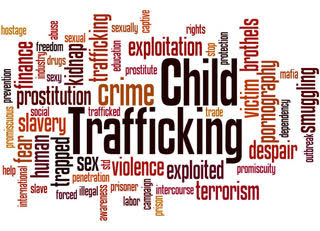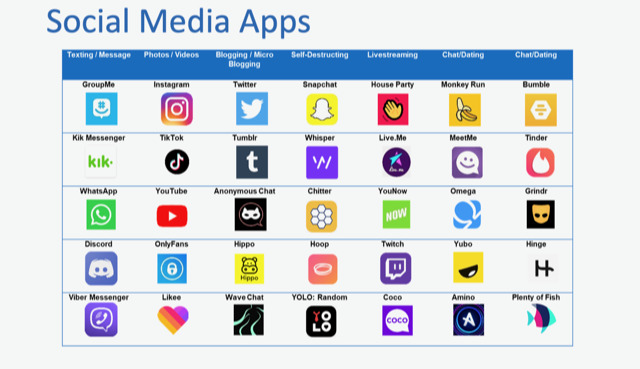
Editor’s Note: The is part II of a two part series. Read part I HERE.
BY DEBBIE PAGE
debbiepage.iredellfrenews@gmail.com
During COVID-19 restrictions when typical teen hangouts like malls, concerts, athletic events were closed down, human traffickers shifted their victim recruiting efforts to social media, apps, and online gaming and messaging.
Trafficking recruitment is now most commonly achieved through some sort of internet contact, which increased 22 percent in 2020 as the pandemic began. Victim recruitment through Facebook was up 125 percent over 2019 and up 95 percent on Instagram.
Teens often get trapped by these online predators through “sextortion,” which occurs by befriending a teen, their gaining trust, and then asking for an explicit photo. The trafficker then threatens to expose the explicit image to friends and family if the victim does not cooperate with the trafficker’s demands.
It is crucial for parents to talk with children early since one in four victims of sextortion are younger than 13 and two in three victims were girls who were threatened before age 16.
Many parents are giving children smartphones or tablets at earlier ages, and often the kids are more tech-savvy than their parents, said Meghann Lail, community training coordinator with Partners Health Management.
Children also must have computer access for school work now, and during COVID-19 school closures, older children were often left to do online school work with limited parental supervision because of work obligations.
The many apps that youths can access, some of which include live-streaming and messaging capabilities, leave them vulnerable to traffickers, who use random messages to establish contact. As soon as issues with one app are identified and fixed, another app pops up in its place.
Even seemingly innocent children’s apps or websites must be closely monitored. Lail said her 11-year-old niece was discovered communicating with a boy through the kid-oriented Roblox site, which has a messaging function. This discovery prompted a serious talk about online safety, said Lail.
MONITORING ONLINE ACTIVITY
Another challenge for parents is that teens can hide apps or change the icon to look like something acceptable such as a calculator. Keepsafe, Private Photo Vault, Calclator#/Privault, Safe Lock, Vault, and Secret Photo Vault SPV are apps designed to help smartphone users hide their online activity.
 Teens also create “family-friendly” versions of Facebook or Instagram (Finsta — or fake Instagram) for adult consumption but have hidden accounts to communicate with friends.
Teens also create “family-friendly” versions of Facebook or Instagram (Finsta — or fake Instagram) for adult consumption but have hidden accounts to communicate with friends.
Lail recommends parents investing in monitoring apps to protect children from internet predators. Our Pact, Famisafe, and Mobicip range from $3.99 to $9.99 per month, and MMGuardian Parent App costs $35 annually.
The cost is worth it to protect teens and kids, according to Lail, since parents cannot monitor online activity all of the time. These apps ensure teens are not downloading an app without permission. Some also limit screen time, let parents see activity or view internet history even if it’s deleted, and monitor text messaging.
Lail said this is not about invading youths’ privacy or managing their lives but about keeping teens and children safe from very real online dangers.
Because device use starts so young, Lail said the time to start talking to kids about internet safety is age 7. Tragically, trafficking victims as young as 7 years old have been reported.
Some resources to help parents and teens learn about internet safety include internetmatters.org, internetsafety101.org, familyzone.com, commonsensemedia.org, and NetSmartzkids.org, which has animated videos to teach young kids about the internet and safe online behavior.
The Internet Crimes Against Children Task Force (ICAC) (icactaskforce.org) also has a wealth of good information.
WATCH BEHAVIOR CLOSELY
Because apps change daily, Lail said it’s important for parents to be alert to signs of exposure to inappropriate material.
In younger children, pay attention to language or terms that indicate exposure, take notice of language that is not age appropriate, look for behaviors that mimic what they may have seen, and listen for clues that they have a new friend online.
Parents of teens should watch for warning signs such as needing to take calls in private, hiding the screen when parents enter the room, becoming increasingly secretive, spending more time online, and not talking openly about online activities.
Vague talk about online friends with few details, patterns of leaving home for periods of time, a new older boy or girl friend, responding to job listings for modeling or acting, or having a lot of new, costly items without known means to purchase them are other warning signals.
STEPS TO GUARD KIDS
Keeping devices out of kids’ bedrooms and avoiding unmonitored use is an important barrier to outside dangers. Device turn-in time and charging in the parents’ bedroom is a good practice to safeguard youths from predatory, late-night online contacts.
Parents can also filter the internet router with parental controls to keep out inappropriate material (tips at https://protectyoungeyes.com/the-ultimate-guide-to-understanding-routers/). Parents should also be aware that predators communicate with kids and teens through Xbox and Playstation consoles as well. Filters can be placed on those devices as well.
Talking with children and teens about internet safety can be awkward but is necessary. The Shared Hope organization offers tips in this discussion guide: https://sharedhope.org/wp-content/uploads/2021/09/How-to-Talk-to-Your-Kids_FactSheet_9.16.21.pdf
THE PERFECT RECRUITMENT TOOL
Technology is an excellent recruitment tool for predators because it enables them to enter children’s homes without revealing their identity. Offenders search for children referencing sex, who appear needy or submissive, or have a continual online presence with little parental intervention or contact.
Traffickers use social media to target kids who seem lonely, with the trafficker offering friendship, false promises, and gradual luring into the trafficker’s web of deceit.
Traffickers may also share pornography with victims to normalize and elicit the sexualized behavior and show children how to perform sexual acts. Sextortion often results after this type of exposure.
The addictive nature of online usage is difficult for adults and even more so for children and teens who are seeking attention and approval.
Lail noted seeing “likes” on Facebook or going viral activates the same areas of the brain as eating chocolate or doing other pleasurable activities.
“The bottom line is that technology is not going away, so it’s important to educate and teach about internet safety and to start these conversations early,” said Lail.
RESOURCES FOR PARENTS
♦ North Carolina’s failing report card on human trafficking: https://reportcards.sharedhope.org/northcarolina/
♦ Common Threads Video – Human Trafficking in North Carolina by Project No Rest: https://www.youtube.com/watch?v=nD21t2kzkts
♦ How to Talk to Youth About Human Trafficking – U.S. Department of Homeland Security: https://www.dhs.gov/sites/default/files/publications/blue_campaign_youth_guide_508_1.pdf
♦ How to Talk to Teens About Dealing with Online Predators – Common Sense Media – https://www.commonsensemedia.org/articles/how-to-talk-to-teens-about-dealing-with-online-predators



